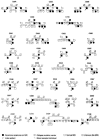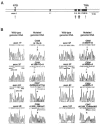Mutations within the MGC4607 gene cause cerebral cavernous malformations
- PMID: 14740320
- PMCID: PMC1181930
- DOI: 10.1086/381718
Mutations within the MGC4607 gene cause cerebral cavernous malformations
Abstract
Cerebral cavernous malformations (CCM) are hamartomatous vascular malformations characterized by abnormally enlarged capillary cavities without intervening brain parenchyma. They cause seizures and focal neurological deficits due to cerebral hemorrhages. CCM loci have already been assigned to chromosomes 7q (CCM1), 7p (CCM2), and 3q (CCM3) and have been identified in 40%, 20%, and 40%, respectively, of families with CCM. Loss-of-function mutations have been identified in CCM1/KRIT1, the sole CCM gene identified to date. We report here the identification of MGC4607 as the CCM2 gene. We first reduced the size of the CCM2 interval from 22 cM to 7.5 cM by genetic linkage analysis. We then hypothesized that large deletions might be involved in the disorder, as already reported in other hamartomatous conditions, such as tuberous sclerosis or neurofibromatosis. We performed a high-density microsatellite genotyping of this 7.5-cM interval to search for putative null alleles in 30 unrelated families, and we identified, in 2 unrelated families, null alleles that were the result of deletions within a 350-kb interval flanked by markers D7S478 and D7S621. Additional microsatellite and single-nucleotide polymorphism genotyping showed that these two distinct deletions overlapped and that both of the two deleted the first exon of MGC4607, a known gene of unknown function. In both families, one of the two MGC4607 transcripts was not detected. We then identified eight additional point mutations within MGC4607 in eight of the remaining families. One of them led to the alteration of the initiation codon and five of them to a premature termination codon, including one nonsense, one frameshift, and three splice-site mutations. All these mutations cosegregated with the disease in the families and were not observed in 192 control chromosomes. MGC4607 is so far unrelated to any known gene family. Its implication in CCMs strongly suggests that it is a new player in vascular morphogenesis.
Figures






References
Electronic-Database Information
-
- Center for Applied Genomics, http://www.cag.icph.org/
-
- Centre d’Etude du Polymorphisme Humain, http://www.cephb.fr/
-
- Chromosome 7 Annotation Project, The, http://www.chr7.org/ (for sequence and SNP information about genomic contigs on chromosome 7)
-
- Cooperative Human Linkage Center, http://gai.nci.nih.gov/CHLC/ (for CCM2 and CCM3 marker selection)
-
- Ensembl, http://www.ensembl.org/Danio_rerio/ and http://www.ensembl.org/Fugu_rubripes/ (for the homology searches)
References
-
- Cave-Riant F, Denier C, Labauge P, Cécillon M, Maciazek J, Joutel A, Laberge-le Couteulx S, Tournier-Lasserve E (2002) Spectrum and expression analysis of KRIT1 mutations in 121 consecutive and unrelated patients with cerebral cavernous malformations. Eur J Hum Genet 10:733–74010.1038/sj.ejhg.5200870 - DOI - PubMed
-
- Couteulx SL, Brezin AP, Fontaine B, Tournier-Lasserve E, Labauge P (2002) A novel KRIT1/CCM1 truncating mutation in a patient with cerebral and retinal cavernous angiomas. Arch Ophthalmol 120:217–218 - PubMed
-
- Craig HD, Gunel M, Cepeda O, Johnson EW, Ptacek L, Steinberg GK, Ogilvy CS, Berg MJ, Crawford SC, Scott RM, Sabroe R, Kennedy CT, Mettler G, Beis MJ, Fryer A, Awad IA, Lifton RP (1998) Multilocus linkage identifies two new loci for a Mendelian form of stroke, cerebral cavernous malformation, at 7p15-13 and 3q25.2-27. Hum Mol Genet 7:1851–185810.1093/hmg/7.12.1851 - DOI - PubMed
-
- Davenport WJ, Siegel AM, Dichgans J, Drigo P, Mammi I, Pereda P, Wood NW, Rouleau GA (2001) CCM1 gene mutations in families segregating cerebral cavernous malformations. Neurology 56:540–543 - PubMed
Publication types
MeSH terms
Substances
LinkOut - more resources
Full Text Sources
Medical
Molecular Biology Databases
Research Materials

